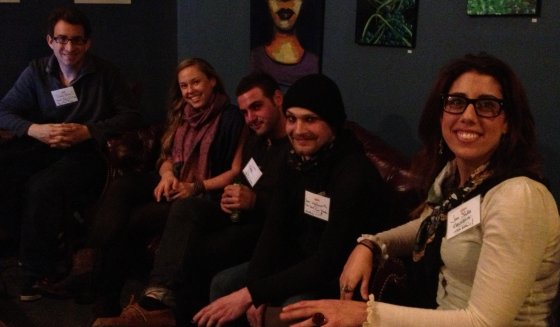About 16 years ago I produced a show called “The Professor of Comedy” at Second City in Chicago. While I wrote, co-starred, and produced the event, the absolute hardest and most stressful part of the entire production was marketing the show and getting people to the event.
Back then I didn’t have the advantage of social media. But social media doesn’t necessarily makes things easier as we’re now competing with so much other noise. Regardless, social media has become a critical part of promoting an event, while we still rely on plenty of in-person techniques to build and maintain our audience.
To share knowledge about how to successfully pack a room, Eventbrite asked me to moderate a panel discussion in San Francisco entitled “Setting Up for Selling Out.”
Joining me on the panel were (from left to right in picture. I’m on the far left.):
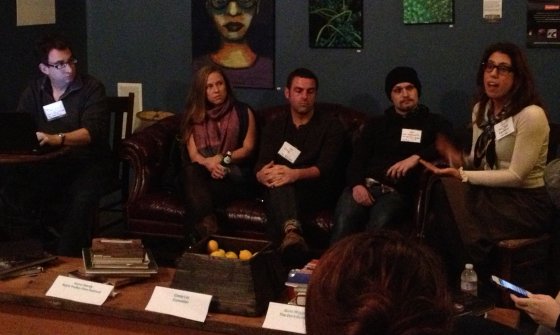
- Kerry Hardy, Senior Marketing Associate for the Napa Valley Film Festival
- Comedian Casey Ley
- Sean Wigglesworth, Managing Director of The Dark Room Theater
- Jenn Stokes, Arts and Entertainment Account Executive for Eventbrite
Here’s a summary of the panelists’ recommendations on what to do/not do when trying to promote yourself as a talent, your venue, or entertainment brand.
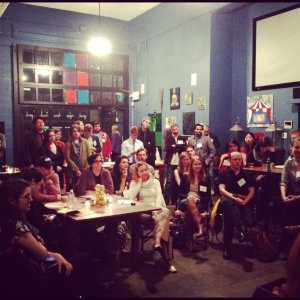 Partner with an organization that has an existing audience – Ley did this successfully but it was only possible in that he brought to the table an established show with a track record.
Partner with an organization that has an existing audience – Ley did this successfully but it was only possible in that he brought to the table an established show with a track record.
Ask people who walk through your door to “Like” you on Facebook – At The Dark Room, Wigglesworth asks people how they heard about the show. If they don’t say Facebook he asks them to “Like” them on Facebook. Using this technique their fan base on Facebook has shot up dramatically (from 700 to 1,200 in just six months) and they can clearly track the success of the Facebook channel.
Get your audience involved in the shows you produce – Whether in person or over social media, ask your audience questions as to what they’d like to see at your event. Try simple polls. They’ll appreciate being involved in getting the show produced.
Facebook event invites barely have any impact – Many of the audience members and panelists agreed that Facebook events carry very little weight because we receive so many of them and there’s no commitment to make. Eventbrite events require an action or an actual payment. With a free event, Stokes said you have to oversell it by 100 people. Even asking a small amount of $5 requires people to become vested in your event.
Use content on Facebook vs. event listings to drive attendance – Instead of using Facebook event listings, Wiggelsworth posts content to Facebook. Facebook’s statistics can show you how viral a piece of content is.
Rely on the quality of the show, not kick ass marketing – You might sell out the first show because you worked your ass off, said Stokes. But if you don’t have good content, it will eventually fail. You must put on continuously good performances.
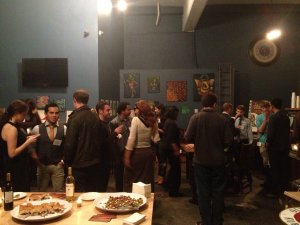 Create teaser content that makes viewer want more – Wigglesworth’s team produced a one minute trailer which sold the fact that their production of “Asteroids,” based on the classic video game, was just going to be a lot of silly dialogue. They got 100 likes on that one video.
Create teaser content that makes viewer want more – Wigglesworth’s team produced a one minute trailer which sold the fact that their production of “Asteroids,” based on the classic video game, was just going to be a lot of silly dialogue. They got 100 likes on that one video.
It’s worth it to selectively promote content on Facebook so that future content will become more visible – When you post on Facebook, about 15 percent of your followers will see that content. For a small sum, about $7-$10, Facebook lets you sponsor that post which will increase the percentage (about 35 percent) of followers who will see the post. On selective content, Wiggelsworth will pay for a sponsored post because it will increase the visibility of future content, according to Facebook’s algorithm.
Enlist tracking links, measure success, and tweak – You’ll never know how well or poor a certain campaign or sponsorship is doing unless you track that. Eventbrite, Bit.ly, and others provide tracking links meaning as that link is shared around the Internet, its use is tracked. Know what you’re tracking and measure how well each is doing and tweak accordingly.
Don’t bark at your network – This is a common first time use of social media. The attitude of “Oh, I can promote my shows” is the first intended use of social media. Yes, you can do that, but don’t make that your only communications with your audience. Give content and ask questions.
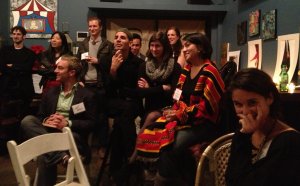 Know your online traffic strategy – To be successful with social media and your event, you have to be clear of the flow that you want. Where do you want them to come first? Do you want them to purchase tickets first, visit your website first, or just connect with you in social media? If you say purchase tickets, it will be a very hard initial sell. If you choose social media, then you’ll have time to build a relationship because you’ve hooked them in your network.
Know your online traffic strategy – To be successful with social media and your event, you have to be clear of the flow that you want. Where do you want them to come first? Do you want them to purchase tickets first, visit your website first, or just connect with you in social media? If you say purchase tickets, it will be a very hard initial sell. If you choose social media, then you’ll have time to build a relationship because you’ve hooked them in your network.
Treat your superfans well and they’ll return in kind – At the Napa Valley Film Festival they give media passes out to their super fans, especially if they have an existing social media presence. Wigglesworth will have a special seat reserved for his superfan Carl, and Carl brings friends every single time he comes to a show. He’ll also usually give free tickets to superfans.
Don’t treat your audience as money walking through the door – Provide a personal touch and recognize them, especially if they’re a returning customer. Over time Wigglesworth has noticed that people will come to a play regardless of the show, just because they love his theater. Others just want to see their friends do something silly on stage.
Give them the VIP treatment – Just saying to someone you’re giving them the VIP treatment doesn’t necessarily mean that it’s going to be an extra cost outlay, but rather just a personal touch. So that could mean you’re reserving a seat for them, or bringing a drink to their seat rather than making them get up to order at the counter. With Eventbrite you can leave notes on individual tickets to provide direction for individualized VIP treatment.
Make fans promoters with tracking links – If they sell a certain number of tickets you can give them a bonus of some sort.
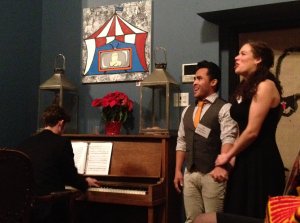 Avoid leaving money on the table: Use tiered pricing and donations – While your ticket may be $20, some people may be willing to pay more. Give them an option with tiered pricing which includes bonuses if you can’t give them better seats. Or, provide a donation link on your homepage and a donation box in the theater.
Avoid leaving money on the table: Use tiered pricing and donations – While your ticket may be $20, some people may be willing to pay more. Give them an option with tiered pricing which includes bonuses if you can’t give them better seats. Or, provide a donation link on your homepage and a donation box in the theater.
Connect donations to specific needs – If you’re going to ask for donations, be specific as to what you need it for. Don’t just ask people to donate. Wigglesworth explains that the ticket prices go to pay for the production of the show, but the donations go for upgrades in the theater, such as new chairs, a new paint job, etc.
Twitter is most useful during the show…if you want that – Depending on the type of production, you may not want people Twittering at the show. It wasn’t until the end of our discussion that we brought up Twitter. None of the panelists found it useful to drive traffic to their show except the night of the show. Stokes joked that Twitter should be called “AAAHHHH! Get here now!”
Comedian Ley uses Twitter to be able to write concise jokes. The others said Twitter is valuable during the show in talking about what’s going on and interacting with people in the audience. Or to communicate with people who weren’t there and want to know what’s going on. All of the panelists agreed that it’s hard to build an audience on Twitter.
Conclusion: Social networking is an extension of face time
“Nothing beats making more friends,” said Wigglesworth. If you have more friends they’ll want to help you out. Wigglesworth said he has friends he’s made solely through the theater and in turn they promote his shows online and bring their friends.
You can find more photos and tweets from the night via Brianna Haag’s Storify piece.

